Mussoorie
Mussoorie is a hill station and a municipal board in the Dehradun District of the Indian state of Uttarakhand. It is about 35 kilometres (22 mi) from the state capital of Dehradun and 290 km (180 mi) north of the national capital of New Delhi. The hill station is in the foothills of the Garhwal Himalayan range. The adjoining town of Landour, which includes a military cantonment, is considered part of "greater Mussoorie", as are the townships of Barlowganj and Jharipani.
Mussoorie Mansūrī | |
|---|---|
Hill Station | |
 View of Mussoorie from the top of Gun Hill | |
| Nickname(s): Queen of the Mountains; Queen of the Hills | |
 Mussoorie Location in Uttarakhand, India | |
| Coordinates: 30.45°N 78.08°E | |
| Country | |
| State | Uttarakhand |
| District | Dehradun |
| Elevation | 2,005 m (6,578 ft) |
| Population (2011) | |
| • Total | 30,118 |
| Languages | |
| • Official | Hindi[1] |
| • Other | Garhwali |
| Time zone | UTC+5:30 (IST) |
| PIN | 248179[2] |
| Vehicle registration | UK 07, UK 09 |
Mussoorie is at an average altitude of 2,005 metres (6,578 ft). To the northeast are the Himalayan snow ranges, and to the south, the Doon Valley and Shiwalik ranges. The second highest point is the original Lal Tibba in Landour, with a height of over 2,275 m (7,464 ft). Mussoorie is popularly known as The Queen of the Hills.[3][4]
History
The name Mussoorie is often attributed to a derivation of mansūr, a shrub which is indigenous to the area. The town is often referred to as Mansuri by most Indians.[5]
In 1803 the Gorkhas under Umer Singh Thapa conquered the Garhwal and the Dehra, whereby Mussoorie was established. On 1 November 1814, a war broke out between the Gorkhas and the British. Dehradun and Mussoorie were evacuated by the Gorkhas by the year 1815 and were annexed to the district of Saharanpur by 1819.
Mussoorie as a resort was established in 1825 by Captain Young, a British military officer. With Mr Shore, the resident Superintendent of Revenues at Dehradun, he explored the present site and jointly constructed a shooting lodge. Lt. Frederick Young of the East India Company came to Mussoorie to shoot game. He built a hunting lodge (shooting box) on the Camel's Back Road, and became a magistrate of Doon in 1823. He raised the first Gurkha Regiment and planted the first potatoes in the valley. His tenure in Mussoorie ended in 1844, after which he served in Dimapur and Darjeeling, later retiring as a General and returning to Ireland. There are no memorials to commemorate Young in Mussoorie. However, there is a Young Road in Dehradun on which ONGC's Tel Bhawan stands.
In 1832, Mussoorie was the intended terminus of the Great Trigonometric Survey of India that began at the southern tip of the country. Although unsuccessful, the Surveyor General of India at the time, George Everest, wanted the new office of the Survey of India to be based in Mussoorie; a compromise location was Dehradun, where it remains. The same year the first beer brewery at Mussoorie was established by Sir Henry Bohle as "The Old Brewery". The brewery opened and closed twice before it was re-established by Sir John Mackinnon as Mackinnon & Co. in 1850.[6]
By 1901 Mussoorie's population had grown to 6,461, rising to 15,000 in the summer. Earlier, Mussoorie was approachable by road from Saharanpur, 58 miles (93 km) away. Accessibility became easier in 1900 with the railway coming to Dehradun, thus shortening the road trip to 21 miles (34 km).[7]

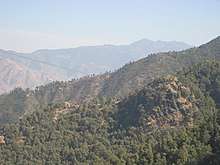
The Nehru family, including Nehru's daughter Indira (later Indira Gandhi) were frequent visitors to Mussoorie in the 1920s, 1930s and 1940s, and stayed at the Savoy Hotel.[8] They also spent time in nearby Dehradun, where Nehru's sister Vijayalakshmi Pandit ultimately settled full-time.
On 20 April 1959 during the 1959 Tibetan Rebellion the 14th Dalai Lama took up residence at Mussoorie, this until April 1960 when he relocated to Dharamsala in Himachal Pradesh,[9] where the Central Tibetan Administration is today headquartered.
The first Tibetan school was established in Mussoorie in 1960. Tibetans settled mainly in Happy Valley. Today, about 5,000 Tibetans live in Mussoorie.[10]
.jpg)
Geography and climate
Mussoorie has an average elevation of about 2,005 metres (6,578 ft). The highest point is "Lal Tibba", at a height of about 2,275 m (7,464 ft), although the name Lal Tibba is now also used to describe a lookout point, a short distance from the peak.
Mussoorie has a fairly typical subtropical highland climate (Köppen Cwb) for the mid-altitude Himalaya. Summers are warm and very wet, with July and August averaging approximately 660 millimetres (26 in) of rain per month due to orographic lift of the extremely moist monsoonal air. The pre-monsoon seasons in April and May is warm to very warm and generally dry and clear, giving way to heavy rainfall from mid-June, while the post-monsoon season is also dry and clear but substantially cooler. In winter, rainfall is a little more frequent than in the pre-and post-monsoon seasons, and the general weather cool and partly cloudy. Mussoorie usually receives a few spells of snowfall in December, January and February, although the number of snowy days has come down in recent years due to a combination of local and global factors, such as deforestation, construction activity and global warming. Between October to February the town shows the rare "winterline" phenomenon.[11]
| Climate data for Mussoorie (1971–2000, extremes 1901–1987) | |||||||||||||
|---|---|---|---|---|---|---|---|---|---|---|---|---|---|
| Month | Jan | Feb | Mar | Apr | May | Jun | Jul | Aug | Sep | Oct | Nov | Dec | Year |
| Record high °C (°F) | 21.1 (70.0) |
23.3 (73.9) |
26.1 (79.0) |
29.1 (84.4) |
34.4 (93.9) |
31.7 (89.1) |
29.4 (84.9) |
25.6 (78.1) |
27.2 (81.0) |
28.1 (82.6) |
25.0 (77.0) |
23.3 (73.9) |
34.4 (93.9) |
| Average high °C (°F) | 10.3 (50.5) |
11.2 (52.2) |
15.7 (60.3) |
20.6 (69.1) |
23.0 (73.4) |
23.2 (73.8) |
20.9 (69.6) |
20.5 (68.9) |
19.8 (67.6) |
18.6 (65.5) |
15.5 (59.9) |
12.7 (54.9) |
17.6 (63.7) |
| Average low °C (°F) | 2.8 (37.0) |
3.4 (38.1) |
7.1 (44.8) |
11.5 (52.7) |
14.3 (57.7) |
15.6 (60.1) |
15.0 (59.0) |
14.8 (58.6) |
13.6 (56.5) |
11.1 (52.0) |
7.6 (45.7) |
4.5 (40.1) |
10.0 (50.0) |
| Record low °C (°F) | −5.0 (23.0) |
−6.7 (19.9) |
−2.5 (27.5) |
−1.5 (29.3) |
3.7 (38.7) |
4.1 (39.4) |
11.7 (53.1) |
7.4 (45.3) |
1.3 (34.3) |
2.6 (36.7) |
−2.1 (28.2) |
−3.9 (25.0) |
−6.7 (19.9) |
| Average rainfall mm (inches) | 49.9 (1.96) |
65.2 (2.57) |
73.1 (2.88) |
56.2 (2.21) |
69.0 (2.72) |
200.9 (7.91) |
629.6 (24.79) |
548.0 (21.57) |
264.5 (10.41) |
55.5 (2.19) |
14.9 (0.59) |
10.1 (0.40) |
2,036.8 (80.19) |
| Average rainy days | 4.1 | 5.0 | 5.1 | 3.8 | 5.0 | 9.5 | 22.4 | 21.3 | 11.6 | 2.7 | 0.9 | 1.3 | 92.7 |
| Average relative humidity (%) (at 17:30 IST) | 78 | 75 | 66 | 56 | 58 | 70 | 85 | 87 | 85 | 78 | 75 | 75 | 74 |
| Source: India Meteorological Department[12][13] | |||||||||||||
Demographics
As of 2011 India census,[14] Mussoorie had a population of 30,118. Males constitute 55% of the population and females 45%. Mussoorie has an average literacy rate of 89%, higher than the national average of 75%: male literacy is 94%, and female literacy is 84%. In Mussoorie, 9% of the population is under 6 years of age. In Mussoorie Nagar Palika Parishad, female sex ratio is of 812 against the state average of 963. Moreover, the child sex ratio in Mussoorie is around 918 compared to Uttarakhand state average of 890.
Landmarks
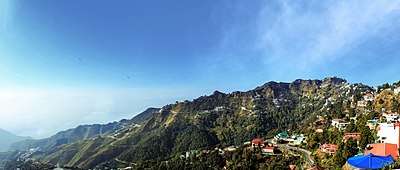
Tourism, concentrated during summer and winter, is the most significant segment of the Mussoorie economy.
Dhanaulti
Dhanaulti is a hill station located 24 km (15 mi) away from Mussoorie. The Doon Valley and snow-covered Garhwal Himalayas can be viewed from there.
Camel's Back Road
Camel's Back Road incorporates a nature walk. The road, which takes its name from a rocky outcrop in the shape of a camel's hump, contains hotels, motels, and a cemetery. The oldest Christian church in the Himalayas, St Mary's, is above Mall Road.
Nahata Estate
Previously known as "Childer's Lodge", Nahata Estate is a property of more than 120 hectares (300 acres) owned by the Harakh Chand Nahata family. It is the highest peak of Mussoorie near Lal Tibba with mountain views, 5 km (3.1 mi) from the Tourist Office.
Gun Hill
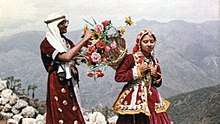
Gun Hill is the second highest point of Mussoorie, at an altitude of 2,024 m (6,640 ft) and at 30.4953°N 78.0745°E, and is accessed by cable car from the Mall road. At Gun Hill is a cannon previously used to sound midday.. It is the second-highest spot after Lal Tibba. Here, Britishers did the reckless firing during their time. So this place is known as Gun Hill.[15]
Kempty Falls
The Kempty Falls, 12 m (40 ft) high and 1,400 m (4,500 ft) above sea level, is 15 km (9.3 mi) from Mussoorie, accessed by track from Kempty Fall Road.
Lake Mist
About 5 km (3 mi) before Kempty Falls on the Mussoorie-Kempty road is Lake Mist, through which flows the Kempty river with its numerous small waterfalls. The resort of Lake Mist provides accommodation, restaurant facilities and boating.
Municipal Garden
The Municipal Garden provides an artificial mini-lake with paddle boats. It is 4 km (2.5 mi) by road transport and 2 km (1 mi) via Waverly Convent School road on foot.
Mussoorie Lake
The newly developed Mussoorie Lake was built by City Board and Mussoorie Dehradun Development Authority. The lake, providing pedal boats and views of Doon Valley and nearby villages, is 6 km (3.5 mi) from Mussoorie on the Mussoorie-Dehradun road.
Bhatta Falls
Bhatta Falls are 7 km (4.5 mi) from Mussoorie on the Mussoorie-Dehradun Road near the village of Bhatta. The falls are 3 km (2 mi) by foot from Bhatta.
Jharipani Fall
Jharipani Fall is on the Mussoorie-Jharipani road, 8.5 km (5.5 mi) from Mussoorie.
Mossy Fall
Mossy Fall is surrounded by a dense forest and is 7 km (4.5 mi) from Mussoorie, and is accessed via Barlowganj or Balahisar.
Sir George Everest's House
At Park Estate are the remains of the building and laboratory of Sir George Everest, the Surveyor-General of India from 1830 to 1843. It is after George Everest that the world's highest peak Mt. Everest is named. It is 6 km (3.5 mi) from Gandhi Chowk and a scenic walk from Library Bazaar, although accessible by road transport to at least Haathi Paon. The place provides a view of Doon Valley on one side and a panoramic view of the Aglar River valley and the peaks of the Himalayan ranges on the other.
Happy Valley
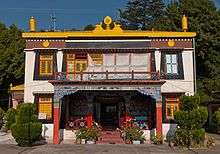
Happy Valley lies on the western side of Library Point. The tourist attraction includes Tibetan sanctuaries, a municipal garden, and the IAS Academy. Lal Tibba is a further tourist attraction in the cantonment of Landour near Mussoorie, and overlooks the Himalayas.
Nag Devta Temple
The ancient Nag Devta Temple is dedicated to Snake God Lord Shiva, It is on Cart Mackenzie Road about 6 km (3.5 mi) from Mussoorie on the road to Dehradun. There is vehicular access to the temple, which provides a view of Mussoorie and the Doon Valley.
Jwalaji Temple (Benog Hill)
At an altitude of 2,240 m (7,350 ft) Jwalaji Temple is 9 km (5.5 mi) west from Mussoorie, and cannot be accessed by vehicle although a motor road goes most of the way from Mussoorie. It is at the top of Benog Hill and contains an idol of the Goddess Durga; from the temple is a view of the valley of the Aglar River.
Cloud End
Cloud End is surrounded by thick deodar forest. The bungalow, built-in 1838 by a British major, was one of the first four buildings in Mussoorie and has been converted to a hotel.
Van Chetna Kendra
Van Chetna Kendra, a 339 hectares (840 acres) sanctuary 11 km (7 mi) to the south from Library Point, was established in 1993. It is significant for the extinct bird species Mountain Quail (Pahari Bater), last spotted in 1876.
Benog Wildlife Sanctuary
The sanctuary, about 11 km (6.8 mi) from Library Point and open to the public, provides a woodland habitat for indigenous birds, and animals.[16]
Mall Road
Mall Road, with architectural evidence of a colonial past, is a shopping area at the centre of Mussoorie, and contains shops, cafes, video game establishments, skating rinks, a nearby Tibetan market place, and a Methodist church.
Lal Tibba
Lal Tibba, also called Depot Hill because of its former use as a military depot, is the highest point in Mussoorie, with views over the town and its surroundings. A Japanese telescope, with views of Himalayan ranges including Badrinath, Kedarnath, Banderpunch, was installed at Lal Tibba in 1967.
Soham Heritage & Art Centre
Bala Hisar is a museum in Uttarakhand that showcases cultural heritage of the state in different art forms.
Education and services
The Landour Community Hospital is a Christian mission hospital run by the Emmanuel Hospital Association, Delhi,[17] which has provided for the medical needs of Mussoorie's hill people for 75 years.
Schools include Woodstock School (1854),[18] Convent of Jesus and Mary, Waverly (1845), St George's College (1853), Oak Grove School (1888), Wynberg-Allen (1888), Guru Nanak Fifth Centenary (1969), and Convent of Jesus and Mary Hampton Court.[18]
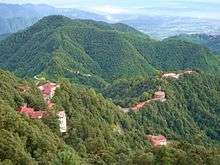
Woodstock School is a Christian, international, co-educational, residential school in Landour, a small hill station contiguous with the town of Mussoorie. The school traces its origin to the 1850s when a group of English ladies were enlisted by British officers and American missionaries to provide a Protestant education for girls.[18] Woodstock is among the most well-known boarding schools of the Indian Subcontinent, said by some to be currently the best international school in India. (Others are the Kodaikanal International School and the Hebron School, Ooty, both in South India.) The school has a campus covering an area of about 100 hectares (250 acres) and is in a forest region with a variety of flora including pine, rhododendron, and oak. The terrain of the campus has an altitude range of 350 metres (1,150 ft) from its lowest point to the highest point. Classes at Woodstock begin from ECP (Early Childhood Program) and follow up to grade 12.[18]
St. George's College, Mussoorie (founded in 1853) is among the oldest schools in the country. It has been run by the Patrician Brothers since 1893. Spread over 160 hectares (400 acres), the school is popularly referred to as "Manor House". The students of this prestigious school are referred to as "Manorites". The school is located in Barlowganj, a small town at the foot of Mussoorie. The school has been awarded as 2nd most beautiful campus in India. In 2005, the Indian Air Force gifted the school a trainer jet aircraft. Thus the school a long rich history to its name. Its alumni have made significant contributions in several fields, especially in serving the armed forces of the nation. The school's facade is one of the main architectural attractions of Mussoorie.
Oak Grove School differs from other schools of Mussoorie, in that it is affiliated with the CBSE, New Delhi, and is a secular government-aided school, run by the Northern Railway. The school was founded in 1888 by the East Indian Railway (EIR) and passed to the Indian Railways when railways were nationalised after Independence. It has three semi-independent wings and is on two hills in Jharipani, 8 km (5 mi) from Mussoorie town, near Jharipani Fall.
Wynberg Allen School was established in 1888. In Kanpur, during the year 1887, a group of friends, Mr. Alfred Powell, Mr. and Mrs. Arthur Foy and Brigadier J H Condon met and decided to set up a school in Mussoorie. The school was built at Jabarkhet along the Tehri road and was later shifted to the present Wynberg Estate. The object was to provide for and give to children of wholly or partly of European descent, an education based on Protestant Christian principles; to maintain such children; and to give them an academic and practical training conducive to economic welfare and happiness. It now accommodates students of all descents. The school consists of two branches—the Junior branch (Wynberg) and the Senior branch (Allen) and accommodates around 700 children. It has four houses: Allen, Powell, Foy and Condon. A student from the institution is referred to as an "Alwynian."
The Convent of Jesus and Mary, Waverley, Mussoorie was established in 1845 by the Religious Sisters of Jesus and Mary Mussoorie Educational Society.
The school is conducted by the Religious Sisters of Jesus and Mary. It is an all-girls school and perhaps the oldest Convent school in India. Waverley is at an elevation of 2,100 m (7,000 ft) above sea level on one of the most extensive and well-wooded hills of Mussoorie. The Jesus and Mary congregation was the first congregation of Sisters to come to the north in 1842 at the invitation of Bishop Borghi the Vicar Apostolic of the Agra Mission. The Archbishop requested the sisters to come to Mussoorie to start a school for girls. In 1845 the sisters came to Mussoorie. The estate of Waverley belonging to an Italian gentleman had just come into the market and the nuns bought it. That year saw the commencement of one of the most important Catholic educational institutions in the North of India. Thousands of girls, Catholic and non-Catholic alike, have since passed through Waverley. The small inadequate bungalow which was all the accommodation at first offered, has given place to a group of buildings which dominate the town of Mussoorie.
The Guru Nanak Fifth Centenary School Mussoorie (GNFCS) is a residential boarding school. Previously owned by the Seventh-day Adventists and known from 1922–1969 as Vincent Hill School, GNFCS purchased the land and extensive buildings and founded an international school to the memory of Sri Guru Nanak Dev Ji, on the occasion of His 500th birth anniversary, celebrated in November 1969. The girls are housed at Shangri La at 2,060 m (6,750 ft) above sea level on an 4.5-hectare (11-acre) plot, wooded with cypress, cedar and oak, on the south and west, facing the Himalayan peaks, to the north. The boys are at Vincent Hill, 3 km (2 mi) from Library Chowk. The school comprises a campus covering 18 hectares (45 acres). The GNFCS prepares students in accordance with the 10+2 formula for school education, for the Indian Certificate of Secondary Education (10-year course) examination and the Indian School Certificate (12-year course) examination.
Other schools in Mussourie include Mussoorie International School (founded in 1984),[19] Mussoorie Modern School, Tibetan Homes, CST Mussoorie and St Clares Convent School.[20]
In Mussorie is the Lal Bahadur Shastri National Academy of Administration,[21] a training institute for officers of the Indian Foreign Service, Indian Administrative Service and other civil services. This academy is approximately 2 km (1 mi) from Gandhi Chowk.
Economy
The economy in Mussoorie is primarily dependent on tourism. Tourists come primarily from New Delhi, Punjab, Haryana and other northern states. In Mussoorie itself, there were 27,94,108 domestic tourist arrivals and 1865 foreign arrivals in 2017.[22] There is a projected 58.5% growth forecast in foreign tourist arrivals due to EVisa nationally.[23] Educational institutions are another contributor to the local economy. The Uttarakhand Government has created investment proposals for the development of a mountain forest resort and a development of ropeways in order to boost tourism in the region. The ropeway which was inaugurated on 6 March 2019 is being built at a cost of ₹3 billion (US$42 million) and is expected to be completed by 2022.[24]
Transport
Mussoorie is connected by road to Delhi and major cities. It is called the "Gateway" to Yamunotri and Gangotri shrines of Northern India.[25] The nearest Airport Jolly Grant in Dehradun is 60 km away from the city[26] The closest rail station is Dehradun. Within Mussoorie are taxis and buses. A ropeway between Purkul Gaon, Dehradun and Mussoorie is in the works.[24] This rope way is projected to reduce traffic congestion and increase tourist footfall to Mussoorie.
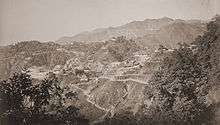 Mussoorie and Landour, 1860s
Mussoorie and Landour, 1860s- Oak Grove School – Junior Wing
 A view of Wynberg Allen School
A view of Wynberg Allen School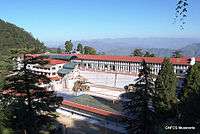 Guru Nanak Fifth Centenary School Shangri-La Girls Campus
Guru Nanak Fifth Centenary School Shangri-La Girls Campus Guru Nanak Fifth Centenary School Vincent-Hill Boys Campus, Mussoorie, est. 1969
Guru Nanak Fifth Centenary School Vincent-Hill Boys Campus, Mussoorie, est. 1969- A look at LBSNAA at night.
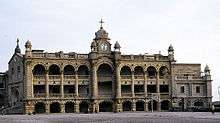 Facade of St. George's College, Mussoorie, established 1853
Facade of St. George's College, Mussoorie, established 1853 Mussoorie at night.
Mussoorie at night.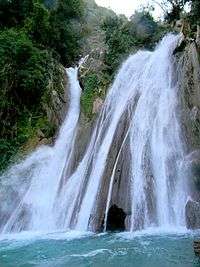 Kempty Water Fall, Mussoorie (in winter)
Kempty Water Fall, Mussoorie (in winter)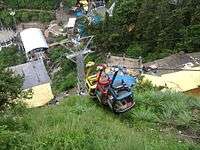 The Ropeway/Cable Car is a tourist attraction in Mussoorie
The Ropeway/Cable Car is a tourist attraction in Mussoorie- A view of Dehradun from Mussourie
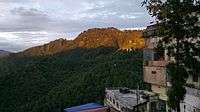 View of the Hills in Mussoorie Towards Sunset
View of the Hills in Mussoorie Towards Sunset Himalayas at dusk from Mussoorie, Uttarakhand
Himalayas at dusk from Mussoorie, Uttarakhand
References
- "52nd REPORT OF THE COMMISSIONER FOR LINGUISTIC MINORITIES IN INDIA" (PDF). nclm.nic.in. Ministry of Minority Affairs. p. 47. Archived from the original (PDF) on 25 May 2017. Retrieved 16 January 2019.
- "Mussoorie Pin code". citypincode.in. Archived from the original on 2 April 2015. Retrieved 3 March 2015.
- Dhir, Laruna (16 March 2018). "Who stripped my Dehradun off its charm?". DailyO. Retrieved 6 April 2018.
- Joshi, Nidhi (23 May 2017). "Mussoorie: The Queen of Hills". Moneycontrol.com. Retrieved 1 March 2018.
- "Mussoorie | Uttarakhand Tourism Development Board | Department of Tourism, Government Of Uttarakhand, India". Retrieved 18 December 2019.
- Misra, Prachi Raturi (3 October 2015). "The Mussoorie brew which had Ghalib hooked". The Times of India. Retrieved 9 April 2020.
-

- Pioneer, The. "Murder at Savoy". The Pioneer. Retrieved 9 April 2020.
- Lama, The 14th Dalai (9 April 2020). "Chronology of Events". The 14th Dalai Lama. Retrieved 9 April 2020.
- "50 Years of Central Tibetan Schools Administration". pib.gov.in. Retrieved 10 May 2020.
- "What causes 'winterline' and why is it visible only in a few places in the world? - Times of India". The Times of India. 15 November 2009. Retrieved 6 April 2020.
- "Station: Mussoorie Climatological Table 1971–2000" (PDF). Climatological Normals 1971–2000. India Meteorological Department. October 2011. pp. 533–534. Archived from the original (PDF) on 15 February 2020. Retrieved 31 March 2020.
- "Extremes of Temperature & Rainfall for Indian Stations (Up to 2012)" (PDF). India Meteorological Department. December 2016. p. M227. Archived from the original (PDF) on 5 February 2020. Retrieved 31 March 2020.
- "Mussoorie Population Census 2011". Census Commission of India. Archived from the original on 16 June 2004. Retrieved 19 September 2016.
- "Places to visit in Mussoorie". Retrieved 26 April 2020.
- "Places to Visit in Mussoorie During Honeymoon". Jaypee Hotels. Archived from the original on 14 June 2018. Retrieved 28 May 2018.
- "Landour Community Hospital". Retrieved 18 December 2019.
- "Woodstock school to host Mussoorie Mountain Festival | Dehradun News - Times of India". The Times of India. Retrieved 18 December 2019.
- "MIS Foundation". Retrieved 18 December 2019.
- "Schools in Mussoorie". 2 March 2013.
- "LBSNAA". civilservices.gov.in.
- Government of Uttarakhand (November 2018). "Development of Mountain Forest Resort" (PDF). uttarakhandtourism.gov.in/wp-content. Retrieved 29 January 2020.
- Government of Uttarakhand (November 2018). "Development of Ropeways in Uttarakhand" (PDF). uttarakhandtourism.gov.in/wp-content. Retrieved 29 January 2020.
- Singh, Kautilya (7 March 2019). "'Doon-Mussoorie ropeway to be among world's 5 longest ropeway projects'". The Times of India. Retrieved 29 January 2020.
- "Mussoorie in Dehradun, India | Travel Guide". FunAlive. Retrieved 18 December 2019.
- "How To Reach Mussoorie (2019)". www.tripcrafters.com. Retrieved 18 December 2019.
External links
![]()
| Wikivoyage has a travel guide for Mussoorie. |
